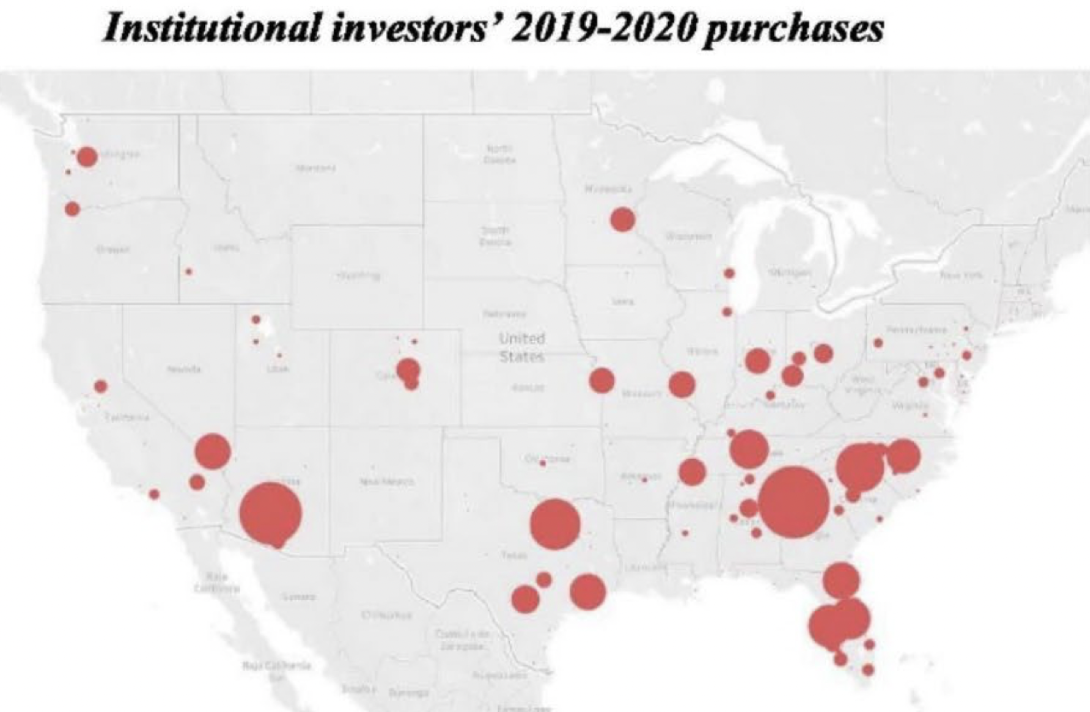INSTITUTE INDEX: Investors are pushing affordable housing out of reach

(Map from appendices produced by the Subcommittee on Oversight and Investigations of the U.S. House Committee on Financial Services.)
Date on which the Oversight and Investigations subcommittee of the U.S. House Committee on Financial Services held a hearing on how institutional investors' expanding ownership of single-family rental homes is putting affordable housing further out of reach for renters and first-time homebuyers: 6/28/2022
Year in which a mortgage foreclosure crisis driven by predatory and racist lending practices sparked the institutional home ownership boom, which in turn was fueled by the federal government's decision to sell non-performing mortgage loans in bulk to Wall Street-backed landlords, as noted in testimony by Sofia Lopez of the Action Center on Race and the Economy: 2010
In 2011, number of individual entities across the entire U.S. that owned over 1,000 single-family rental homes: 0
Eleven years later, number of U.S. homes owned or operated by the five largest rental home operators — Invitation Homes, Pretium Partners (parent company of Progress Residential), American Homes 4 Rent, FirstKey Homes, and Tricon Residential — whose holdings are concentrated in the Southeast and Southwest: almost 300,000
On average, percent of non-white residents in the neighborhoods where these companies buy homes: 84
Rank of Memphis among U.S. metro areas with the greatest share of investor ownership of single-family rental homes: 1
Rank of Atlanta and the Texas communities of Lubbock, McAllen, and Brownsville, respectively: 2, 3, 4, 5
In 2021, percent by which Dallas-based Invitation Homes — which like many of these companies offers a publicly traded real estate investment trust on the New York Stock Exchange — raised rents in Atlanta and Jacksonville, Florida, respectively: 20, 19
Percent by which Invitation Homes' profits jumped from 2020 to 2021: 33
Number of pages in one Invitation Homes lease renewal, making the tenant financially responsible for things like bedbug infestations and excusing the company from liability for things like mold: 39
According to company data requested by the subcommittee, average number of days it took Invitation Homes to complete maintenance requests in 2021: 10.9
Percent paying occupancy assumed by the rent-backed securities comprising most of Invitation Homes' debt, creating an incentive to quickly evict tenants who run into payment problems: 94
According to a 2015 discussion paper prepared for the Federal Reserve Bank of Atlanta by hearing witness Elora Raymond of the Georgia Institute of Technology, who studies institutional investor landlords, percentage points by which eviction filings by those landlords exceeded eviction filings overall: 13
Rank of renting from an institutional investor among the biggest risks for eviction, according to Raymond's research: 1
Six years after an investor purchase in an Atlanta neighborhood, change in the number of Black and white residents, respectively, compared to neighborhoods without such a purchase: -166 and +109
Even though Congress allocated billions of dollars to support renters during the COVID-19 pandemic, number of eviction actions Invitation Homes filed nationwide from the pandemic's start in March 2020 to November 2021: over 1,300
In the first quarter of this year, percent of single-family homes for sale nationwide that were bought by investors — a new record, as noted in testimony from Jim Baker with the Private Equity Stakeholder Project, a nonprofit that tracks private equity's impacts on ordinary people: 28
In that same period, percent of single-family homes for sale in Atlanta that were bought by investors, who can make quick all-cash offers and exploit legally complex tax avoidance schemes: 33.1
Portion of all single-family rental homes now owned by investors in North Carolina's Mecklenburg County, whose seat is Charlotte: 1 in 4
Given the capital currently flooding the industry, number of additional single-family rental homes nationwide expected to come under institutional investor ownership over the next decade: 1 million
(Click on figure to go to source.)
Tags
Sue Sturgis
Sue is the former editorial director of Facing South and the Institute for Southern Studies.
